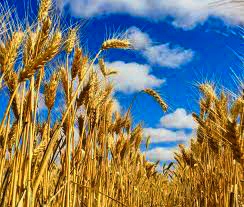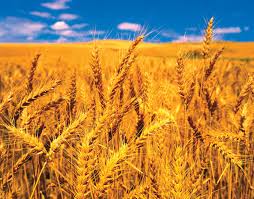Wheat Rate in Pakistan Today 2024:
The suggested Minimum Support price of wheat by the government of Pakistan for the year 2024 is as: Wheat Rate in Pakistan Today 2024 May is given below see the gandum Rate in Pakistan. Atta price in Pakistan
- Province Punjab Govt price: Rs. 2700 to 3150 PKR
- Sindh Province Govt price: Rs. 2800 to 3100 PKR

Wheat Rate in Punjab Pakistan Today 2024 :
Province: Punjab
Minimum Rate per 40 Kg: Rs. 2700 PKR
Maximum Rate per 40 Kg: Rs. 3150 PKR
Average Rate per 40 Kg: Rs. 2800 PKR
What is the price of wheat in Pakistan? What is the price of 1kg wheat? What is the current price of wheat?
Wheat Rate in Sindh Pakistan today 2024:
Province: Sindh
Minimum Rate per 40 Kg: Rs. 2800 PKR
Maximum Rate per 40 Kg: Rs. 3100 PKR
Average Rate per 40 Kg: Rs. 2900 PKR
Q: What is Wheat?
Wheat is a cereal grain, originally from the Levant region of the Near East and Ethiopian Highlands, but now cultivated worldwide. It is one of the most important staple crops, and is ground into flour to make a wide variety of foods, including bread, pasta, pastry, and crackers. There are many different varieties of wheat, such as hard and soft wheat, and they are used for different purposes depending on their protein and gluten content.
Q: Wheat production in Pakistan:
Pakistan is one of the major wheat-producing countries in the world. Wheat is the most important staple food crop in Pakistan, and it is the second largest crop in terms of cultivated area and the third largest in terms of production. The country has a total wheat-growing area of around 8.7 million hectares, and it produced around 25 million tons of wheat in 2020-2021.
In this article, Wheat Rate in Pakistan Today 2024, The main wheat-growing regions in Pakistan include the Punjab, Sindh, and Khyber Pakhtunkhwa provinces, which account for the majority of the country’s wheat production. The Punjab province is the largest producer of wheat in Pakistan, followed by Sindh and Khyber Pakhtunkhwa. The majority of the wheat grown in Pakistan is of the Indus-30 variety, which is known for its high yield and tolerance to high temperatures.
Pakistan’s wheat production has been increasing in recent years due to government policies to encourage wheat cultivation, improving farming techniques, and the use of high-yielding varieties. The country’s wheat production has been affected by a variety of factors, including weather conditions, pests and diseases, and government policies.
Pakistan’s wheat production is important for its economy and food security. It is the main source of food for the majority of the population, and it is also a major export crop. The country exports wheat to various countries in the Middle East, Africa, and Asia.
Q: Wheat production in term of Pakistan GDP?
Wheat is an important crop for Pakistan’s economy, and it contributes significantly to the country’s Gross Domestic Product (GDP). According to the Pakistan Bureau of Statistics (PBS), the agriculture sector, of which wheat is a major component, accounted for around 21% of the country’s GDP in 2020-2021.
Wheat production is a significant source of income for farmers and rural communities in Pakistan, and it is also an important source of employment, particularly in the rural areas where most of the wheat is grown. The wheat crop also provides a significant source of food for the country’s population, which is essential for food security.
In addition to its direct contributions to GDP, the wheat sector also supports other industries such as flour milling, animal feed production and bakeries, which in turn contribute to the GDP.
Challenges:
While we are reading today Wheat Rate in Pakistan 2024, we will know It’s worth noting that the agricultural sector in Pakistan is also affected by various Challenges such as water scarcity, lack of mechanization, and limited access to markets and finance. These challenges can affect the productivity and profitability of wheat farming, and it can also affect the overall contribution of the wheat sector to the GDP.
Therefore, it is important for the government to address these challenges and support the wheat farmers with modern techniques, access to credit and markets, and research and development, to ensure that the wheat sector continues to be a significant contributor to the country’s GDP.
Q: What major challenges to Pakistan in wheat production?
There are several major challenges facing the wheat production sector in Pakistan, which include:
- Water scarcity: Pakistan is facing a severe water shortage, and this is a major challenge for the country’s agriculture sector, including wheat production. Irrigation systems are often inadequate and inefficient, which can lead to reduced crop yields.
- Soil degradation: The overuse of chemical fertilizers and pesticides, combined with poor farming practices, has led to soil degradation in many parts of Pakistan. This can reduce the productivity of wheat crops.
- Climate change: Climate change is affecting the country’s wheat production, with increasing temperatures and changing weather patterns leading to reduced crop yields and increased incidence of pests and diseases.
- Pests and diseases: Wheat is susceptible to a variety of pests and diseases, and these can cause significant crop losses if not controlled.
- Lack of mechanization: Many farmers in Pakistan still rely on manual labor for planting, cultivating and harvesting wheat, which can increase costs and reduce productivity.
- Limited access to markets and finance: Many farmers in Pakistan face limited access to markets and finance, which can make it difficult for them to sell their crops at a fair price, and to invest in modern equipment or new technologies.
- Government policies: Government policies can also affect the wheat production, if they are not supportive or well-designed it can lead to reduced productivity and profitability for farmers.
- Political instability: Political instability and insecurity can also affect the wheat production in Pakistan, as it can disrupt trade and transportation, and make it difficult for farmers to access markets and finance.
Q: What solution for Major Challenges to Pakistan in wheat production?
By reading the article Wheat Rate in Pakistan Today 2024 we will learn how to overcome these challenges, the government of Pakistan needs to implement policies and programs that support farmers, such as providing access to modern technology and equipment, promoting sustainable farming practices, and investing in research and development to improve crop yields and reduce the impact of pests and diseases.
Q: What are the different types of wheat?
There are many different types of wheat, each with its own unique characteristics. Some of the most common types include:
- Hard wheat: This type of wheat has a high protein content and is typically used for bread making. It contains more gluten, which gives bread its characteristic chewiness. Hard wheat is also known as bread wheat.
- Soft wheat: This type of wheat has a lower protein content and is typically used for pastry making. It is also known as pastry wheat.
- Durum wheat: This type of wheat is particularly high in protein and is used to make pasta.
- Spelt wheat: This is an ancient variety of wheat that is similar to durum wheat, but it has a slightly sweeter taste.
- Emmer wheat: This is another ancient variety of wheat that is similar to spelt.
- Einkorn wheat: This is an ancient variety of wheat that is considered as the oldest type of wheat.
- Kamut: This is an ancient variety of wheat that is sweeter and nuttier in flavor.
- Rye: This is not a wheat, but sometimes it’s used in combination with wheat to make bread or other products. see also Atta price in Pakistan today
Each of these types of wheat has its own unique characteristics, and they are used for different purposes depending on their protein and gluten content.

Q: What are the nutritional benefits of Wheat?
Wheat is a rich source of several important nutrients, including:
- Carbohydrates: Wheat is mostly composed of carbohydrates, which provide energy to the body.
- Fiber: Whole wheat is a good source of dietary fiber, which helps to promote regular bowel movements and may reduce the risk of certain types of cancer.
- Protein: Wheat contains a moderate amount of protein, which is important for growth and repair of body tissues.
- B vitamins: Wheat is a good source of several B vitamins, including thiamin, riboflavin, niacin, and folate. These vitamins are essential for energy production and the health of the nervous system.
- Iron: Wheat is a good source of iron, which is important for the formation of red blood cells and the transport of oxygen in the body.
- Zinc: Wheat contains zinc, which is important for the immune system and wound healing.
- Selenium: Wheat contains selenium, which is an antioxidant that helps to protect the body against damage from free radicals.
It’s worth noting that these benefits mostly come from whole wheat and whole wheat products, while refined wheat (white flour) has been processed and many of the nutrients are removed during the process.
Q: What are the main end-uses for Wheat?
There are many different end-uses for wheat, as it is one of the most versatile cereal grains. Some of the main end-uses for wheat include:
- Food: The most common end-use for wheat is as a food ingredient, particularly for making flour for bread, pasta, pastry, crackers, and other baked goods.
- Animal feed: Wheat is also used as a feed grain for livestock, particularly for poultry and swine. The wheat is ground into a coarse meal or cracked to make it more palatable for animals.
- Industrial uses: Wheat is used in a variety of industrial applications, such as the production of adhesives, biofuels, and textiles.
- Alcohol: Wheat is used to make beer and some types of whiskey and other spirits.
- Food additives: Wheat gluten, wheat germ oil, and wheat germ are also used in food production as food additives.
- Traditional uses: In some cultures, wheat is used for traditional rituals and ceremonies, such as making offerings to gods or ancestors.
- Health supplements: Wheat germ oil and wheat germ are also used as a dietary supplements for their nutritional benefits.
- Pharmaceuticals: Wheat is also used in the production of some pharmaceuticals, such as glucose and dextrin.
Q: How does the price of wheat fluctuate?
The price of wheat can fluctuate due to a variety of factors, including supply and demand, weather conditions, government policies, and global economic conditions. Some of the main factors that can affect the price of wheat include:
- Weather conditions: Adverse weather conditions, such as drought or excessive rainfall, can reduce the yield of wheat and lead to higher prices. Conversely, favorable weather conditions can lead to a larger wheat crop and lower prices.
- Supply and demand: The price of wheat is also affected by the balance between supply and demand. When demand for wheat is high and the supply is low, prices will generally rise. Conversely, when demand is low and the supply is high, prices will generally fall.
- Government policies: Government policies can also affect the price of wheat. For example, if a government imposes tariffs on imported wheat, the price of domestic wheat may increase.
- Global economic conditions: Global economic conditions, such as a recession, can reduce the demand for wheat and lead to lower prices. Conversely, a strong economy can increase demand and lead to higher prices.
- Competition with other crops: The price of wheat may fluctuate with the prices of other crops, such as corn or soybeans, as farmers may shift their focus to other crops if their price is more favorable.
- Stock levels: The stock levels of wheat, both in the country and globally also affects the price of wheat. If the stock levels are high, the price of wheat is likely to decrease.
Q: What are the major producing countries of wheat?
Wheat is grown in many countries around the world, but the major producing countries are:
- China: China is the world’s largest producer of wheat, with an annual production of around 130 million tons.
- India: India is the second-largest producer of wheat, with an annual production of around 110 million tons.
- United States: The United States is the third-largest producer of wheat, with an annual production of around 55 million tons.
- Russia: Russia is the fourth-largest producer of wheat, with an annual production of around 55 million tons.
- France: France is the fifth-largest producer of wheat, with an annual production of around 40 million tons.
- Canada: Canada is the sixth-largest producer of wheat, with an annual production of around 30 million tons.
- Australia: Australia is the seventh-largest producer of wheat, with an annual production of around 25 million tons.
- Pakistan: Pakistan is the eighth-largest producer of wheat, with an annual production of around 25 million tons.
- Germany: Germany is the ninth-largest producer of wheat, with an annual production of around 20 million tons.
- Ukraine: Ukraine is the tenth-largest producer of wheat, with an annual production of around 20 million tons.
By reading the article on topic of Wheat Rate in Pakistan today 2024 you will learn about, It’s worth noting that these numbers are subject to change due to weather conditions, pests and diseases, and other factors that can affect crop yields. Wheat Rate in Pakistan Today May 2024 Also, many other countries are also producing wheat but in smaller quantities. gandum Rate in Pakistan 2024 Also read 50 KG wheat price in Pakistan, Wheat price in Pakistan Punjab, and Wheat price in Pakistan Sindh to be fully aware of the Wheat Rate in Pakistan today 2024.










